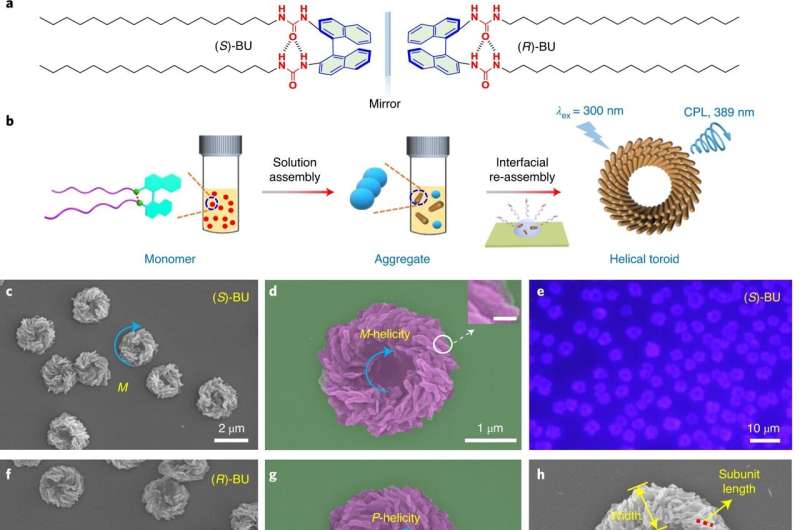Researchers develop hierarchically self-assembled homochiral helical microtoroids

Chirality is essential for life, which can be observed in biological systems hierarchically from the molecular level to macromolecules and higher ordered nanostructures, such as 3D enzymes and micrometer cell membranes. Chirality is precisely controlled within these hierarchical architectures so that a series of life processes can enantio-selectively proceed. Although molecular self-assembly is widely used to fabricate nano/microstructures, a precise chirality control from small molecules extending to micrometer-scale assemblies with satisfied dispersity and homochirality is still a challenge.
In a study published in Nature Nanotechnology, the research group led by Prof. Liu Minghua from the Institute of Chemistry of the Chinese Academy of Sciences developed a combined solution-interface-directed self-assembly strategy to prepare monodispersed microstructures with controlled chirality to a micrometer scale.
Prof. Liu's group had previously developed a solution assembly method to obtain micrometer-scale chiral Mobius strip, a special topological structure with a single edge and a single side, but it suffered from unsatisfied yield and size dispersity. In this study, the researchers proposed a combined solution and interface self-assembly approach to solve these problems by taking the advantages of interfacial assembly, i.e., to reduce the degree of freedom and chiral control of interfacial tension.
Starting from amphiphilic binaphthalene bisurea (BU) enantiomers, the self-assembly was first initiated in methanol by a heating-cooling protocol to form a supersaturated BU solution. Nanoscale molecular aggregates could be formed upon controlled cooling from 343 to 293 K at a speed of 5 K/min, as evidenced by cryo-TEM image, dynamic light scattering data and variable-temperature nuclear magnetic resonance spectra. These dispersed aggregates were then immediately transferred onto 2D substrates such as silica wafer, glass, mica and quartz plate.
Upon evaporation at 293 K, the nanoaggregates underwent morphological fusion and re-assembly under the control of interfacial tension and chiral interactions between the aggregates, leading to the formation of micrometer-sized toroidal structures with satisfactory dispersity and preferred helicity, which depends on the molecular chirality of starting building blocks.
Additionally, an aggregation-cyclization self-assembly mechanism was proposed based on collective experimental data and the molecular dynamic simulations, which indicated the circular stacking tendency of the solution aggregates. By comparing the chiroptical properties of the monomers, solution aggregates and interfacial microtoroids, the researchers found that the toroidal organization of the solution aggregates on a surface played an important role in defining the expression of the overall circular dichroism and circularly polarized luminescence properties.
When doping a chiral acceptor to the chiral microtoroids to establish a chiral light-harvesting antenna, the energy-transfer mediated circularly polarized luminescence of the co-assembled donor-acceptor systems was refined by the helicity direction of the microtoroids, indicating a unique microscopic-chirality controlled structure-property relationship.
The formation of micrometer-sized homochiral and monodispersed microstructures, together with the developed chiral light-harvesting antenna model, provides new insights for chiral self-assembly materials.
More information: Cong Du et al, Hierarchically self-assembled homochiral helical microtoroids, Nature Nanotechnology (2022). DOI: 10.1038/s41565-022-01234-w
Journal information: Nature Nanotechnology
Provided by Chinese Academy of Sciences





















